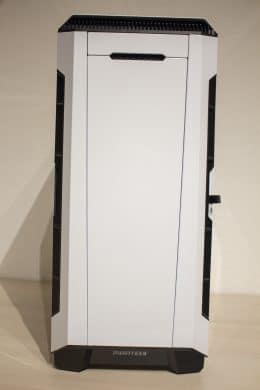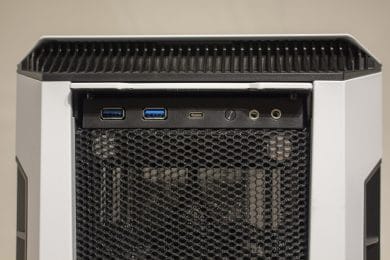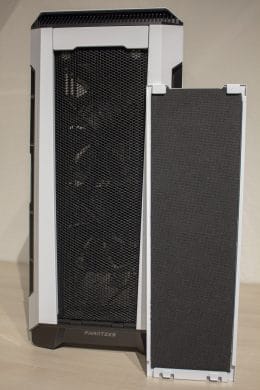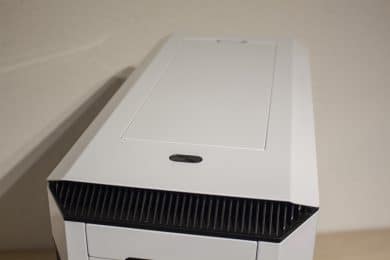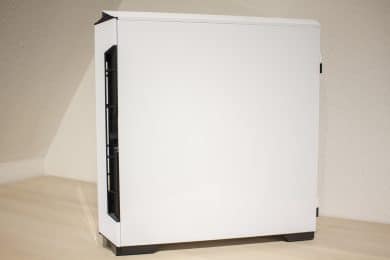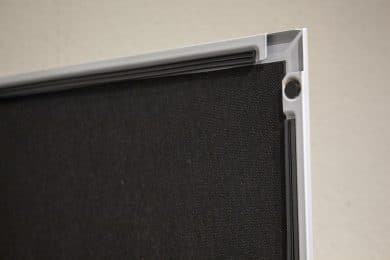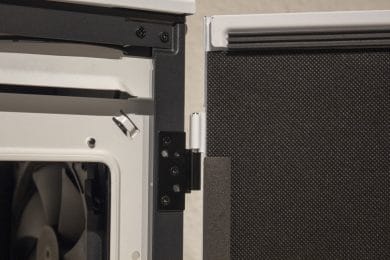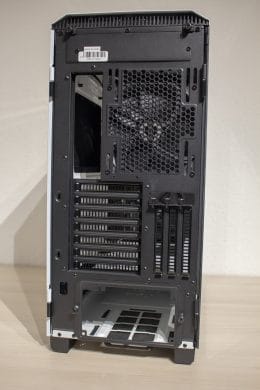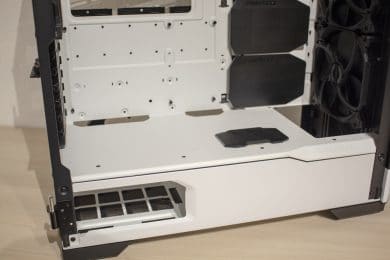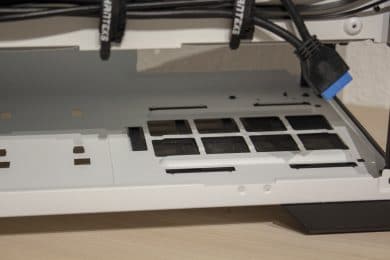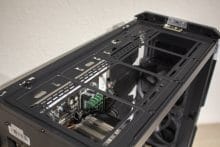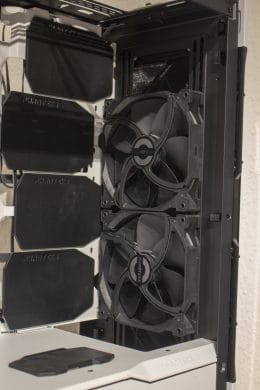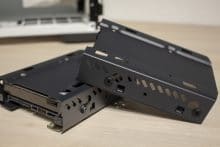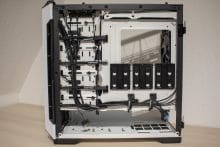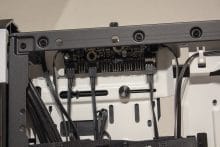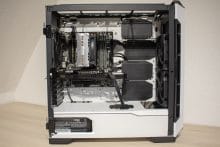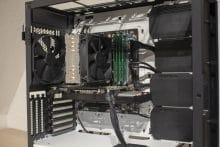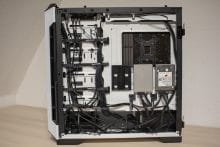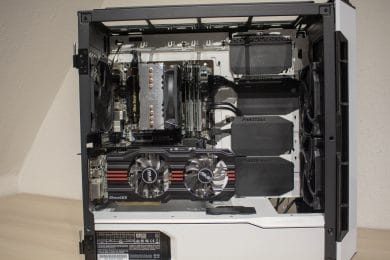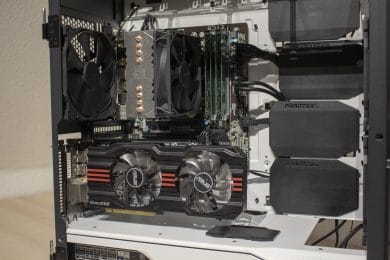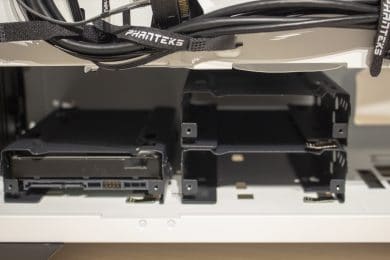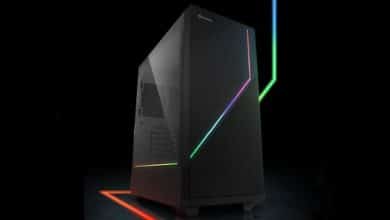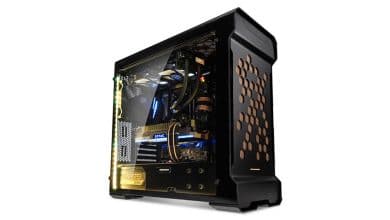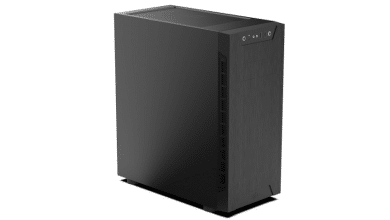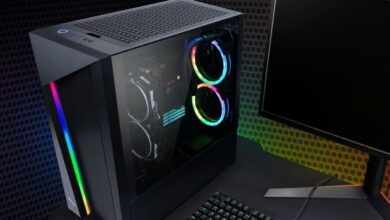
At Computex 2018, the Dutch manufacturer Phanteks presented the long-awaited successor to the Eclipse series as a prototype for the first time. At the CES 2019 the case was officially presented. The relatively large midi tower is named Eclipse P600S, is based on the body of the Phantek Enthoo Evolv X and should be suitable for both silent and high-end systems with a high airflow requirement. Additionally Phanteks advertises the possibility to install two systems into the Eclipse P600S at the same time. To round off the range, the manufacturer offers the housing in a total of six different versions. It is available in three different colours (black, anthracite, white) and with or without tempered glass side windows. The version with side window are available for 149,90 € and for the Eclipse P600S without side window 139,90 € must be placed on the counter.
In the following test we take a closer look at the Phanteks Eclipse P600S in white with side window and tell you if it’s worth buying this midi tower.
Specifications
| Model: | Eclipse P600S |
| Housing type: | Midi Tower |
| Dimensions: | 240 x 520 x 510 mm (WxHxD) |
| Weight: | 13.5 kg |
| Material: | Steel, Plastic, Tempreed Glass, |
| Color: | Satin Black, Anthracite Grey, Glacier White |
| Front connections | 1x USB 3.1 Type-C, 2x USB 3.0, 1x speaker, 1x microphone |
| Drive bays: | 10x 3.5″/ 2.5″ (4x included) 3x 2,5″ (3x included in delivery) |
| Extension slots: | 10 (7x horizontal, 3x vertical) |
| Form factors: | E-ATX (up to 280 mm), ATX, mATX, mini-ITX |
| Ventilation: | Front: 3x 120/ 3x 140 mm Cover: 3x 120/ 2x 140 mm Rear: 1x 120/ 1x 140 mm Installed it: Front: 2x 140 mm Rear 1x 140 mm |
| Radiators: | Front: 240 / 280 / 360 / 420mm Lid: 240 / 280 / 260 mm Rear: 140 mm |
| Max. CPU cooler height: | 190 mm |
| Max. Graphics card length: | 435 mm |
| Place for front radiator | 95 mm |
| Place for lid radiator | 65 mm |
| Max. Power supply length: | max. 195 mm (with HDD cage) max. 250 mm (without HDD cage) |
| Cable management space: | 30 mm |
| Price: | 149,90€ |
Packaging and Scope of Delivery

The Phanteks Eclipse P600S comes well and safely packed in a brown cardboard box with all important features, specifications and a picture of the case printed in black or white. Inside the carton you will find the case, which is wrapped in soft plastic foam and a black fabric bag. To prevent scratches, there is also a protective film on the outside of the tempered glass side panel. The included accessories also come packed in a cardboard box. This includes all necessary screws in a practical plastic box, a detailed user manual, a few cable ties, an airflow cover for the lid, a holder for vertical GPU mounting, four mounting frames for 3.5″ data carriers and a holder to prevent the graphics card from hanging down.
Furthermore, three pre-installed case fans with a frame width of 140 mm, a PWM-capable control board for up to eight fans and the pre-installed spacers for the mainboard are included in the scope of delivery.
Exterior Impression
Externally, the Phanteks P600S looks very simple and unobtrusive overall. But let’s start at the front first. This is almost completely closed and consists mainly of a matt and white lacquered steel. Only on the side and in the upper area there are black painted air inlets for the front fans. The manufacturer has hidden the I/O panel in the upper area behind a flap and equipped it with the following connectors: 1x USB 3.1 Type-C connector (internal USB 3.1 plug), 2x USB 3.0 Type-A, 1x microphone, 1x headphone, 1x reset.
Especially interesting in the front is the possibility to remove an element to increase the airflow. This element is held in place by magnets, is made entirely of steel and lined with an insulating mat. Behind it, a special fabric fan grille appears which, according to Phanteks, should increase the air throughput compared to a normal mesh grille. To protect the system from dust, a fine dust filter was installed in front of the two pre-installed 140 mm fans.
The lid is also similarly equipped. The insulation element used here also has magnets and conceals a fabric grid. To disassemble the cover section, simply loosen the knurled screws on the back and remove the entire cover cover upwards. Below is a removable mounting frame for three 120mm fans, two 140mm fans or radiators. Finally, as with all Phanteks cases, the white illuminated power button can be found in the lid.
Both side parts are mounted on hinges on the body and swing to the side when opened. To ensure that both sides remain closed during transport, the side panels each have two very strong magnets. The left side part is made of tempered glass and not tinted. The right side part is completely made of steel, lined with an insulating mat and has an additional pull-out aid in the form of a fabric flap. To further enhance the silent properties of the Eclipse P600S and improve the airflow inside the case, both side panels also have a rubber seal.
The back shows the same appearance as the Phanteks Enthoo Evolv X. The power supply unit is mounted at the bottom and above it there are a total of 10 PCI slot apertures. Seven of these apertures are horizontal and three are vertical. The latter are used for vertical mounting of graphics cards. Furthermore, the third pre-installed 140 mm fan and the opening for the I/O shield can be found on the back. Attentive observers will also have noticed that a further cover plate was attached in the upper area. This is the assembly area for the second system in ITX format.
Finally, we take a look at the underside. The Eclipse P600S stands on solid feet, each of which is equipped with a layer of rubber to protect the floor. To protect the power supply from dust, the manufacturer has also installed a fine dust filter. Fortunately, this filter has a sturdy plastic frame and an extraction aid to facilitate removal or cleaning.

The workmanship, painting and also the material quality is basically very good. However, the removable element in the cover at the back does not close flush with the rest and the flap for the I/O panel could also be a little more accurate. At a price of 149,90 € we would have expected more attention to detail.
Internal Impression
As already mentioned, the corpus and thus the interior are based on the Phantek Enthoo Evolv X. This leads to an interior that is divided into two chambers by a cover. The power supply unit and two mounting locations for the HDD frames supplied are hidden underneath this cover. In order to facilitate the laying of cables, there are additional openings in the power supply cover and a large section has been removed from the front area to allow thicker radiators to be used.
As usual, the mainboard and the expansion cards can be placed above the cover. Especially impressive is the enormous space the Phanteks Eclipse P600S offers. Especially above the mounting position for the mainboard there is still plenty of room. There’s a good reason for that. As in the Enthoo Evolv X it is possible to install a second system in the ITX form factor in the Eclipse P600S. However, the required accessories are not included in the scope of delivery and must be purchased retroactively.
Phanteks has installed black plastic cover plates on the left side of the mainboard tray. These have two functions: first, they cover the openings for cable management and can be pushed back and forth as required. On the other hand, they cover the mounting options for the hard disk cages.
Hard disk cages is a good keyword at this point. The Eclipse P600S can accept three 2.5″ data carriers and four 3.5″ data carriers from the factory. All frames are completely made of steel and have rubber rings for decoupling. With the large hard drive cages, the buyer also has the choice of mounting them under the power supply cover or directly behind the front fans.
Finally, we take a look at the back. The very well equipped cable management system is particularly striking here. There are numerous and well-placed holding points with double-sided, reusable Velcro strips. In addition, the pre-cabling ex works is excellent. Another feature is hidden in the upper left corner. The manufacturer has also equipped the Eclipse P600S with a PWM-capable fan controller. A total of eight fans (3x 3pin, 5x 4pin) can be connected here and controlled via a PWM port on the motherboard. Fortunately, the power is supplied via a connection with the SATA standard.
System Construction in Phanteks Eclipse P600S
Now we come to system installation. As hardware I use a Intel Xeon 1230v3 on a Gigabyte H87M-D3H with 16GB RAM. The Xeon is cooled by an LC-Power Cosmo Cool LC-CC-120 and an HD 7850 2GB from Asus is responsible for the image output. The power supply does the non-modular be quiet! pure power with 400W.
The installation of the components was completed quickly and was a lot of fun. Due to the generous space available and the pre-installed spacers, the main components were quickly installed and wired. The very well thought-out and well equipped cable management system deserves special mention here. The existing Velcro strips, the sensibly placed openings and the individually movable plastic plates make it very easy to create a tidy system. Even on the back side there is a clear arrangement of the cables.
In terms of space, high-end components are no problem either. The Eclipse P600S supports CPU coolers up to 190 mm and graphics cards up to 435 mm in length. Depending on the hard disk configuration, at least 195 mm are available for power supply units. Those who also want to present their graphics card in a vertical position can do so with the Eclipse P600S due to the included holder. What is not included is a PCIe-Riser-cable. This must be purchased retroactively. Even though we don’t have a riser cable, we still mounted the GPU vertically once.
Another sophisticated system was implemented during the assembly of the data carriers. The system works partially without tools, has decouplers and allows stacking at least with the large HDD trays. Both systems look solid and should hold the hard disks securely in place even during transport.
Water Cooling in Phanteks Eclipse P600S
When Phanteks developed the Eclipse P600S, he also placed special emphasis on compatibility with water cooling systems. A maximum of 420 mm radiator can be installed in the front of the Eclipse and 360 mm radiator in the lid. However, the combination of radiator and fan must not exceed a total depth of 95 mm in the front and 65 mm in the cover. In order to facilitate the emptying of the cooling circuit, Phanktes has equipped the radiator holder in the lid and the front area with a possibility to install a drain port there.
Temperatures and Volume
Finally, we come to the temperature measurements. For this I ran Prime95 and Furmark for 15 minutes at a room temperature of 16.5°C and then determined the temperature of the processor and graphics card with the CPUID HWMonitor. Four different scenarios were measured:
1. housing fan at full speed, all insulation elements mounted
2. housing fan at normal speed, all insulation elements mounted
3. housing fan at full speed, all insulation elements removed
4. housing fan at normal speed, all insulation elements removed
The results are shown in the diagram below:
As you can see, there is almost no difference in temperature between the two scenarios where the fans rotate at full speed. This indicates that the fans have a good airflow at full speed and that the front element is not as restrictive as you might think. But even the maximum values with the installed silent covers and downregulated fans are still in the green.
The pre-installed fans can be heard at full speed due to the air turbulence from the case. If you connect the PWM board to a mainboard and reduce the fan speed to 70 % or 80 %, you get a very quiet system depending on the installed components.
Conclusion about Phanteks Eclipse P600S
Let us now come to the conclusion of this review. The Phanteks Eclipse P600S is a well thought out and equipped case. On the plus side there is the good cable management system, the compatibility for high-end components and water cooling as well as the high quality dust filters. In addition, features such as the preparation for the installation of a second system, the magnetic side panels and silent covers and the presence of a USB 3.1 type C port in the front round off the range.
There is not much to complain about with the Eclipse P600S. Only the partially not completely flush and somewhat rickety mounting of the silent cover in the lid is a point to be criticized here. Finally, with the few shortcomings and all the praise, one must not forget the price. After all, this is a proud 149,90 € and you can expect a lot from a package for that. In this price segment, however, the choice becomes quite thin. So there are a handful of other candidates, but most of them focus completely on Silent or optics in the form of RGB and many glass elements.
So if you’re looking for a solid and well-equipped case that’s suitable for both silent builds and high-end builds with water cooling, the Phanteks Eclipse P600S would be an attractive, but not quite affordable candidate.
Phanteks Eclipse P600S
Workmanship
Features
Assembly
Cooling
Value for Money
Very well equipped and spacious midi tower with excellent silent characteristics.
